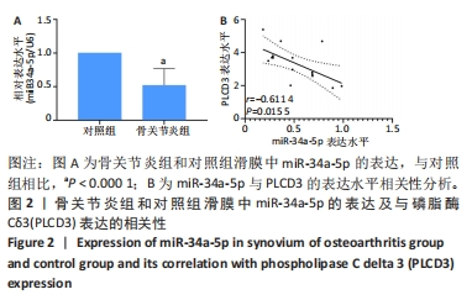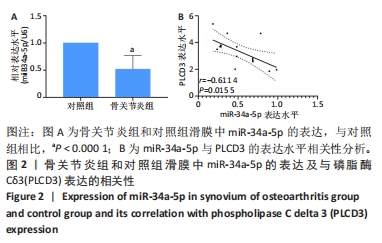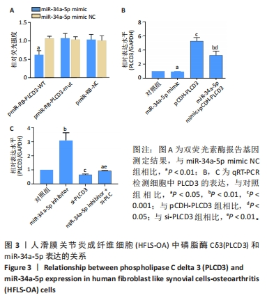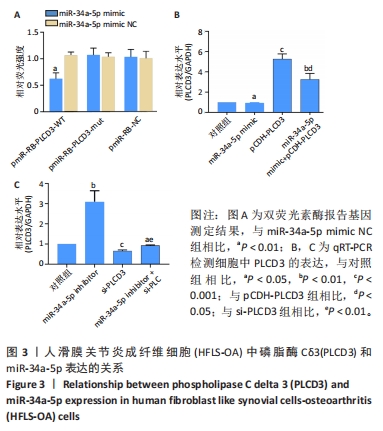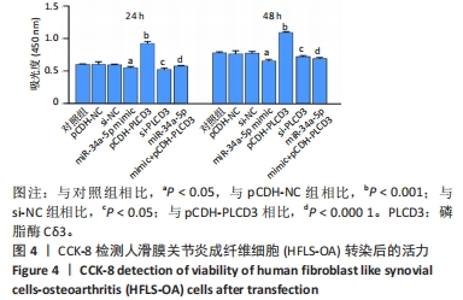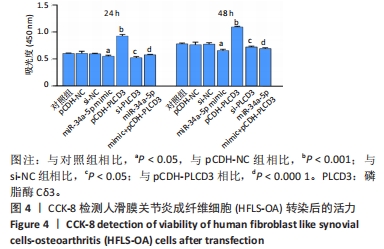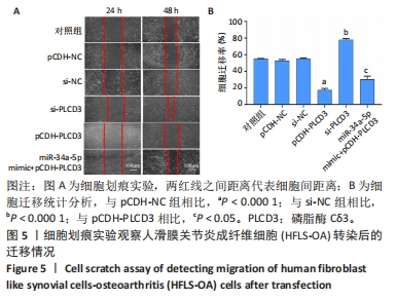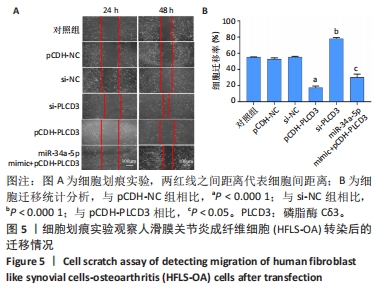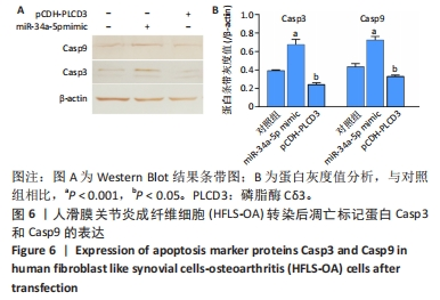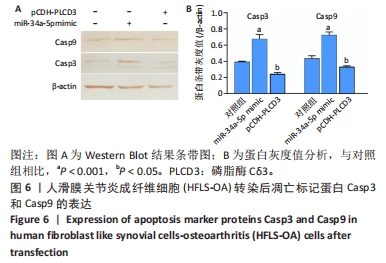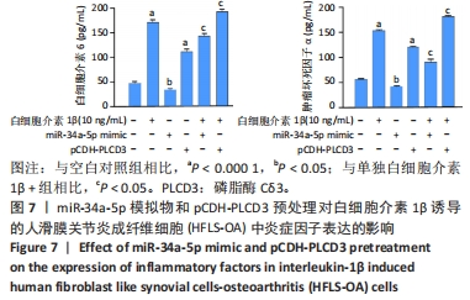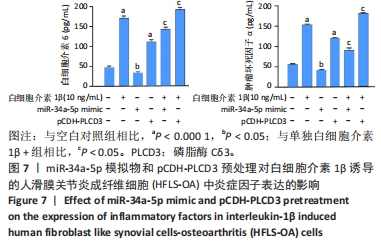Chinese Journal of Tissue Engineering Research ›› 2024, Vol. 28 ›› Issue (33): 5320-5325.doi: 10.12307/2024.653
Previous Articles Next Articles
Mechanism by which miR-34a-5p/PLCD3 axis regulates osteoarthritis progression
Ying Pu, Xu Yue, Lu Tong, Xue Yi, Miao Yiming
- Changshu Hospital Affiliated to Nanjing University of Chinese Medicine, Changshu 215500, Jiangsu Province, China
-
Received:2023-08-14Accepted:2023-10-12Online:2024-11-28Published:2024-01-30 -
Contact:Miao Yiming, Chief physician, Changshu Hospital Affiliated to Nanjing University of Chinese Medicine, Changshu 215500, Jiangsu Province, China -
About author:Ying Pu, MD, Associate chief physician, Changshu Hospital Affiliated to Nanjing University of Chinese Medicine, Changshu 215500, Jiangsu Province, China -
Supported by:Suzhou Science and Technology Development Plan Guiding Project, No. SKJYD2021007 (to YP); Suzhou Science and Technology Development Plan Guiding Project, No. SKJYD2021202 (to MYM); Suzhou “Science, Education and Health” Youth Science and Technology Project, No. KJXW2020068 (to YP); Key Project of Changshu Municipal Health Commission Science and Technology Plan, No. CSWS202118 (to YP); a grant from Changshu Hospital Affiliated to Nanjing University of Chinese Medicine, No. cszyy201910 (to YP)
CLC Number:
Cite this article
Ying Pu, Xu Yue, Lu Tong, Xue Yi, Miao Yiming. Mechanism by which miR-34a-5p/PLCD3 axis regulates osteoarthritis progression[J]. Chinese Journal of Tissue Engineering Research, 2024, 28(33): 5320-5325.
share this article
Add to citation manager EndNote|Reference Manager|ProCite|BibTeX|RefWorks
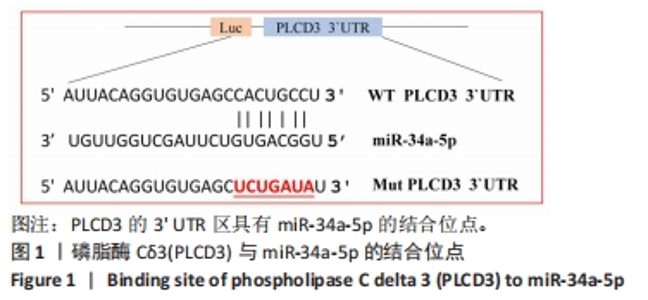
2.1 PLCD3是miR-34a-5p的直接靶标 PLCD3的3’ UTR区具有miR-34a-5p的结合位点,见图1。qRT-PCR结果显示,骨关节炎组滑膜中miR-34a-5p表达水平明显低于对照组(P < 0.05);相关性分析结果显示miR-34a-5p与PLCD3的表达水平呈现负相关(r=-0.611,P < 0.05),见图2。随后的双荧光素酶报告基因实验进一步验证了PLCD3和miR-34a-5p之间的关系,miR-34a-5p模拟物转染后,WT组中PLCD3的相对荧光素酶活性显著下降(P < 0.05);而在PLCD3 mut组没有下降,见图3A。进一步通过qRT-PCR分析miR-34a-5p模拟物、pCDH-PLCD3和miR-34a-5p模拟物+pCDH-PLCD3对HFLS-OA细胞中PLCD3表达的影响,结果显示,miR-34a-5p的过表达可抑制PLCD3表达,miR-34a-5p沉默则促进PLCD3表达,见图3B,C。此外,转染miR-34a-5p模拟物或抑制剂分别削弱了pCDH-PLCD3对PLCD3表达的促进作用和si-PLCD3诱导的抑制作用。上述结果表明PLCD3是miR-34a-5p的直接靶点。"
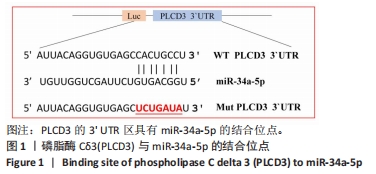
| [1] ABRAMOFF B, CALDERA FE. Osteoarthritis: Pathology, Diagnosis, and Treatment Options. Med Clin North Am. 2020;104(2):293-311. [2] Foster NE, Eriksson L, Deveza L, et al. Osteoarthritis year in review 2022: Epidemiology & therapy. Osteoarthritis Cartilage. 2023; 31(7):876-883. [3] De Roover A, Escribano-Núñez A, Monteagudo S, et al. Fundamentals of Osteoarthritis: Inflammatory mediators in Osteoarthritis. Osteoarthritis Cartilage. 2023;31(10):1303-1311. [4] Cao X, Cui Z, Ding Z, et al. An osteoarthritis subtype characterized by synovial lipid metabolism disorder and fibroblast-like synoviocyte dysfunction. J Orthop Translat. 2022;33:142-152. [5] Wu X, Sun AR, Crawford R, et al. Inhibition of Leukotriene A4 Hydrolase Suppressed Cartilage Degradation and Synovial Inflammation in a Mouse Model of Experimental Osteoarthritis. Cartilage. 2023: 19476035231169940. [6] Chen X, Gong W, Shao X, et al. METTL3-mediated mA modification of ATG7 regulates autophagy-GATA4 axis to promote cellular senescence and osteoarthritis progression. Ann Rheum Dis. 2022;81(1): 87-99. [7] Mimpen JY, Baldwin MJ, Cribbs AP, et al. Interleukin-17A Causes Osteoarthritis-Like Transcriptional Changes in Human Osteoarthritis-Derived Chondrocytes and Synovial Fibroblasts In Vitro. Front Immunol. 2021;12:676173. [8] Park H, Lee HR, Shin HJ, et al. p16INK4a-siRNA nanoparticles attenuate cartilage degeneration in osteoarthritis by inhibiting inflammation in fibroblast-like synoviocytes.Biomater Sci. 2022;10(12): 3223-3235. [9] Maglaviceanu A, Wu B, Kapoor M. Fibroblast-like synoviocytes: Role in synovial fibrosis associated with osteoarthritis. Wound Repair Regen. 2021;29(4):642-649. [10] Lin L, Wen J, Lin B, et al. Phospholipase C Delta 3 inhibits apoptosis and promotes proliferation, migration, and invasion of thyroid cancer cells via Hippo pathway. Acta Biochim Biophys Sin (Shanghai). 2021;53(4):481-491. [11] Dou XL, Xia FD, Li XY. Circ_0003747 promotes thyroid cancer progression by sponging miR-338-3p to upregulate PLCD3 expression. Epigenetics. 2023;18(1):2210339. [12] Nakamura Y, Kanemaru K, Kojima R, et al. Simultaneous loss of phospholipase Cδ1 and phospholipase Cδ3 causes cardiomyocyte apoptosis and cardiomyopathy. Cell Death Dis. 2014;5(5):e1215. [13] Ali SA, Espin-Garcia O, Wong AK, et al. Circulating microRNAs differentiate fast-progressing from slow-progressing and non-progressing knee osteoarthritis in the Osteoarthritis Initiative cohort. Ther Adv Musculoskelet Dis. 2022;14:1759720X221082917. [14] Balaskas P, Goljanek-Whysall K, Clegg PD, et al. MicroRNA Signatures in Cartilage Ageing and Osteoarthritis. Biomedicines. 2023;11(4):1189. [15] Kim M, Rubab A, Chan WCW, et al. Osteoarthritis year in review 2022: Genetics, genomics and epigenetics. Osteoarthritis Cartilage. 2023;31(7):865-875. [16] 应璞, 路通, 许岳, 等.基于生物信息学挖掘骨关节炎潜在的关键生物标志物[J].国际检验医学杂志,2023,44(4):406-411. [17] Song AF, Kang L, Wang YF, et al. MiR-34a-5p inhibits fibroblast‑like synoviocytes proliferation via XBP1. Eur Rev Med Pharmacol Sci. 2020; 24(22):11675-11682. [18] Tian F, Wang J, Zhang Z, et al. LncRNA SNHG7/miR-34a-5p/SYVN1 axis plays a vital role in proliferation, apoptosis and autophagy in osteoarthritis. Biol Res. 2020;53(1):9. [19] Endisha H, Datta P, Sharma A, et al. MicroRNA-34a-5p Promotes Joint Destruction During Osteoarthritis. Arthritis Rheumatol. 2021; 73(3):426-439. [20] 中华医学会骨科学分会关节外科学组.骨关节炎诊疗指南(2018年版)[J].中华骨科杂志,2018,38(12):11. [21] 中华医学会骨科学分会关节外科学组, 中国医师协会骨科医师分会骨关节炎学组, 国家老年疾病临床医学研究中心(湘雅医院), 等.中国骨关节炎诊疗指南(2021年版)[J].中华骨科杂志,2021, 41(18):24. [22] Knights AJ, Redding SJ, Maerz T. Inflammation in osteoarthritis: the latest progress and ongoing challenges. Curr Opin Rheumatol. 2023;35(2):128-134. [23] Ali SA, Peffers MJ, Ormseth MJ, et al. The non-coding RNA interactome in joint health and disease. Nat Rev Rheumatol. 2021; 17(11):692-705. [24] Veronesi F, Costa V, Bellavia D, et al. Epigenetic Modifications of MiRNAs in Osteoarthritis: A Systematic Review on Their Methylation Levels and Effects on Chondrocytes, Extracellular Matrix and Joint Inflammation. Cells. 2023;12(14):1821. [25] Feng L, Yang Z, Li Y, et al. MicroRNA-378 contributes to osteoarthritis by regulating chondrocyte autophagy and bone marrow mesenchymal stem cell chondrogenesis. Mol Ther Nucleic Acids. 2022;28:328-341. [26] Coutinho de Almeida R, Ramos YFM, et al. RNA sequencing data integration reveals an miRNA interactome of osteoarthritis cartilage. Ann Rheum Dis. 2019;78(2):270-277. [27] Chen HW, Huang CH, Huang CF, et al. Distinct subsets of synovial fibroblasts control cartilage destruction in joint diseases. Clin Exp Rheumatol. 2023 Sep 6. doi: 10.55563/clinexprheumatol/txl9rm. [28] Maglaviceanu A, Wu B, Kapoor M. Fibroblast-like synoviocytes: Role in synovial fibrosis associated with osteoarthritis. Wound Repair Regen. 2021;29(4):642-649. [29] Schuster R, Rockel JS, Kapoor M, et al. The inflammatory speech of fibroblasts. Immunol Rev. 2021;302(1):126-146. [30] CHWASTEK J, KĘDZIORA M, BORCZYK M, et al. Inflammation-Driven Secretion Potential Is Upregulated in Osteoarthritic Fibroblast-Like Synoviocytes. Int J Mol Sci. 2022;23(19):11817. |
| [1] | Li Yongjie, Fu Shenyu, Xia Yuan, Zhang Dakuan, Liu Hongju. Correlation of knee extensor muscle strength and spatiotemporal gait parameters with peak knee flexion/adduction moment in female patients with knee osteoarthritis [J]. Chinese Journal of Tissue Engineering Research, 2024, 28(9): 1354-1358. |
| [2] | Qi Haodong, Lu Chao, Xu Hanbo, Wang Mengfei, Hao Yangquan. Effect of diabetes mellitus on perioperative blood loss and pain after primary total knee arthroplasty [J]. Chinese Journal of Tissue Engineering Research, 2024, 28(9): 1383-1387. |
| [3] | Du Changling, Shi Hui, Zhang Shoutao, Meng Tao, Liu Dong, Li Jian, Cao Heng, Xu Chuang. Efficacy and safety of different applications of tranexamic acid in high tibial osteotomy [J]. Chinese Journal of Tissue Engineering Research, 2024, 28(9): 1409-1413. |
| [4] | Huang Xiarong, Hu Lizhi, Sun Guanghua, Peng Xinke, Liao Ying, Liao Yuan, Liu Jing, Yin Linwei, Zhong Peirui, Peng Ting, Zhou Jun, Qu Mengjian. Effect of electroacupuncture on the expression of P53 and P21 in articular cartilage and subchondral bone of aged rats with knee osteoarthritis [J]. Chinese Journal of Tissue Engineering Research, 2024, 28(8): 1174-1179. |
| [5] | Zhao Garida, Ren Yizhong, Han Changxu, Kong Lingyue, Jia Yanbo. Mechanism of Mongolian Medicine Erden-uril on osteoarthritis in rats [J]. Chinese Journal of Tissue Engineering Research, 2024, 28(8): 1193-1199. |
| [6] | Li Rui, Zhang Guihong, Wang Tao, Fan Ping. Effect of ginseng polysaccharide on the expression of prostaglandin E2/6-keto-prostaglandin 1alpha in traumatic osteoarthritis model rats [J]. Chinese Journal of Tissue Engineering Research, 2024, 28(8): 1235-1240. |
| [7] | Zhang Kefan, Shi Hui. Research status and application prospect of cytokine therapy for osteoarthritis [J]. Chinese Journal of Tissue Engineering Research, 2024, 28(6): 961-967. |
| [8] | Zhang Zeyi, Yang Yimin, Li Wenyan, Zhang Meizhen. Effect of foot progression angle on lower extremity kinetics of knee osteoarthritis patients of different ages: a systematic review and meta-analysis [J]. Chinese Journal of Tissue Engineering Research, 2024, 28(6): 968-975. |
| [9] | Shen Feiyan, Yao Jixiang, Su Shanshan, Zhao Zhongmin, Tang Weidong. Knockdown of circRNA WD repeat containing protein 1 inhibits proliferation and induces apoptosis of chondrocytes in knee osteoarthritis [J]. Chinese Journal of Tissue Engineering Research, 2024, 28(4): 499-504. |
| [10] | Maisituremu·Heilili, Zhang Wanxia, Nijiati·Nuermuhanmode, Maimaitituxun·Tuerdi. Effect of intraarticular injection of different concentrations of ozone on condylar histology of rats with early temporomandibular joint osteoarthritis [J]. Chinese Journal of Tissue Engineering Research, 2024, 28(4): 505-509. |
| [11] | Qiao Hujun, Wang Guoxiang. Evaluation of rat osteoarthritis chondrocyte models induced by interleukin-1beta [J]. Chinese Journal of Tissue Engineering Research, 2024, 28(4): 516-521. |
| [12] | Liu Yuhan, Fan Yujiang, Wang Qiguang. Comparison of protocols for constructing animal models of early traumatic knee osteoarthritis [J]. Chinese Journal of Tissue Engineering Research, 2024, 28(4): 542-549. |
| [13] | Zhang Yaru, Chen Yanjun, Zhang Xiaodong, Chen Shenghua, Huang Wenhua. Effect of ferroptosis mediated by glutathione peroxidase 4 in the occurrence and progression of synovitis in knee osteoarthritis [J]. Chinese Journal of Tissue Engineering Research, 2024, 28(4): 550-555. |
| [14] | Liu Luxing, Di Mingyuan, Yang Qiang. Signaling pathways in the mechanism underlying active ingredients of Chinese medicine in the treatment of osteoarthritis [J]. Chinese Journal of Tissue Engineering Research, 2024, 28(4): 609-614. |
| [15] | Yan Binghan, Li Zhichao, Su Hui, Xue Haipeng, Xu Zhanwang, Tan Guoqing. Mechanisms of traditional Chinese medicine monomers in the treatment of osteoarthritis by targeting autophagy [J]. Chinese Journal of Tissue Engineering Research, 2024, 28(4): 627-632. |
| Viewed | ||||||
|
Full text |
|
|||||
|
Abstract |
|
|||||
